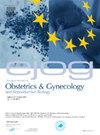综合生物信息分析揭示了子宫内膜异位症的基因特征、表观遗传作用和调控网络。
IF 2.1
4区 医学
Q2 OBSTETRICS & GYNECOLOGY
European journal of obstetrics, gynecology, and reproductive biology
Pub Date : 2024-09-19
DOI:10.1016/j.ejogrb.2024.09.026
引用次数: 0
摘要
目的:子宫内膜异位症是一种常见的妇科疾病,造成了巨大的经济负担。越来越多的证据表明,异常基因表达和表观遗传机制在子宫内膜异位症的发病机制中起着重要作用。本研究旨在利用综合生物信息学方法确定子宫内膜异位症中潜在的关键基因、表观遗传特征和调控网络:从基因表达总库(GEO)数据库下载了六个芯片和 RNA 序列数据集(GSE23339、GSE7305、GSE25628、GSE51981、GSE120103 和 GSE87809)。使用 GEO2R 工具分析了每个数据集中的差异表达基因(DEGs),随后鉴定了它们的 mRNA、miRNA 和 lncRNA 成分。合并数据集之间的共同 DEGs,并使用 ShinyGo 分析基因本体(GO)和通路富集。使用 STRING 和 Cytoscape 构建了 DEGs、miRNA 和 lncRNA 的蛋白-蛋白相互作用(PPI)网络,然后使用 CytoHubba 确定了 PPI 网络中的前 15 个枢纽基因:结果:从四项或四项以上的研究中共鉴定出551个常见的DEGs,包括292个上调基因和259个下调基因。除了蛋白编码基因(mRNA)的改变外,所有研究中还发现了16个miRNA(5个上调,11个下调),以及至少三项研究中常见的12个lncRNA(10个上调,2个下调)。富集的DEGs主要与细胞外基质(ECM)相互作用、P53信号通路和局灶粘附有关,这些因素被认为在子宫内膜异位症的发病机制中发挥着重要作用。通过对常见DEGs的PPI网络构建,得到了178个节点和683条边,从中发现了15个枢纽基因,包括CDK1、CCNB1、KIF11、CCNA2、BUB1B、DLGAP5、BUB1、TOP2A、ASPM、CEP55、CENPF、TPX2、CCNB2、KIFC、NCAPG:我们的深入生物信息学分析揭示了子宫内膜异位症的关键分子基础。结论:我们的深入生物信息学分析揭示了子宫内膜异位症的关键分子基础,已发现的枢纽基因、miRNA 和 lncRNA 的作用也有可能成为子宫内膜异位症诊断和预后的潜在生物标志物。本文章由计算机程序翻译,如有差异,请以英文原文为准。
Integrated bioinformatic analysis reveals the gene signatures, epigenetic roles, and regulatory networks in endometriosis
Objectives
Endometriosis is a common gynecological disease with a significant economic burden. Growing evidence has suggested the role of aberrant gene expression and epigenetic mechanisms in the pathogenesis of endometriosis. This study aims to identify potential key genes, epigenetic features, and regulatory networks in endometriosis using an integrated bioinformatic approach.
Methods
Six microarray and RNA-sequencing datasets (GSE23339, GSE7305, GSE25628, GSE51981, GSE120103, GSE87809) were downloaded from the Gene Expression Omnibus (GEO) database. The differentially expressed genes (DEGs) of each dataset were analyzed using the GEO2R tool, and their mRNA, miRNA, and lncRNA components were identified subsequently. The common DEGs between datasets were combined, and the Gene ontology (GO) and pathway enrichment were analyzed using the ShinyGo. The protein–protein interaction (PPI) network of DEGs, miRNA, and lncRNA was constructed using STRING and Cytoscape, and then the top 15 hub genes in the PPI network were identified using CytoHubba.
Results
A total of 551 common DEGs were identified from four or more studies, including 292 upregulated and 259 downregulated genes. Besides alterations in protein-coding genes (mRNA), 16 miRNA (5 upregulated and 11 downregulated) were identified from all studies, along with 12 lncRNA (10 upregulated and 2 downregulated) that were common in at least three studies. Enriched DEGs were mainly associated with extracellular matrix (ECM) interaction, P53 signaling pathway, and focal adhesion, which are suggested to play vital roles in the pathogenesis of endometriosis. Through PPI network construction of common DEGs, 178 nodes and 683 edges were obtained, from which 15 hub genes were identified, including CDK1, CCNB1, KIF11, CCNA2, BUB1B, DLGAP5, BUB1, TOP2A, ASPM, CEP55, CENPF, TPX2, CCNB2, KIFC, NCAPG.
Conclusions
Our in-depth bioinformatics analysis reveals the critical molecular basis underlying endometriosis. The role of identified hub genes, miRNA, and lncRNA may also have an opportunity to be explored as potential biomarkers for endometriosis diagnosis and prognosis.
求助全文
通过发布文献求助,成功后即可免费获取论文全文。
去求助
来源期刊
CiteScore
4.60
自引率
3.80%
发文量
898
审稿时长
8.3 weeks
期刊介绍:
The European Journal of Obstetrics & Gynecology and Reproductive Biology is the leading general clinical journal covering the continent. It publishes peer reviewed original research articles, as well as a wide range of news, book reviews, biographical, historical and educational articles and a lively correspondence section. Fields covered include obstetrics, prenatal diagnosis, maternal-fetal medicine, perinatology, general gynecology, gynecologic oncology, uro-gynecology, reproductive medicine, infertility, reproductive endocrinology, sexual medicine and reproductive ethics. The European Journal of Obstetrics & Gynecology and Reproductive Biology provides a forum for scientific and clinical professional communication in obstetrics and gynecology throughout Europe and the world.

 求助内容:
求助内容: 应助结果提醒方式:
应助结果提醒方式:


